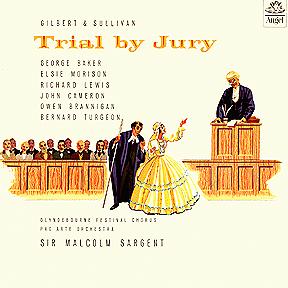The Sargent/EMI Trial By Jury (1961)
Pro Arte Orchestra Recorded 29-30 December 1960 |
|
This Trial is easily the strongest entry in the series of G&S recordings led by Sir Malcolm Sargent from 1957 to 1963. The recording has the feel of a stage production, with audible laughs, gasps, sighs and cheers at the twists and turns of Gilbert's riotous plot. Arthur Jacobs's liner notes in the first-edition LP (not reproduced in the re-issues) tell a bit about how this was achieved:
It was not enough, the recording company felt, to use stereo in Trial By Jury merely to reproduce the spatial feeling of a concert platform. A theatrical work ought to seem theatrical; there ought to be movement across the stage, and towards and away from the footlights, detectable in your living room as theatre.
So Colin Graham, noted young British director, was called in.... [Recording supervisor Peter] Andry, who has supervised all these Gilbert & Sullivan recordings of Sir Malcolm's, had arranged for a "stage" to be provided in the studio. Not a raised stage, but a big square divided into sixty-four numbered squares as though for some giant game of chess. The sides of each of the smaller squares were about two feet long. The cast moved over the numbered squares during performance, each carrying a paper bearing Mr. Graham's instructions—for example, "Bridesmaids enter from 56-7 to 46-7, chattering until they sing."
Dan Kravetz noted:
The sound effects on the Sargent Trial were not added, but recorded during the actual session. This is according to the liner notes of the original U.S. LP by Arthur Jacobs, who described how the session was planned and executed. Jacobs mentions how "water from far Cologne" was poured for the Plaintiff from a pitcher, making sure there was already a bit of water in the cup when the pouring started, so a trickle-trickle would register immediately at the proper time. A critic reviewing the original release complained that it sounded like someone had decided to plant a microphone in the "gents."
All the Sargent recordings are strong, at least musically, but this is perhaps the one that can be safely recommended as a first choice.
The recording was originally issued on a single LP. In later years it was not as easy to come by as the other Sargent sets, perhaps because EMI felt embarassed issuing a disc with so little playing time. It was digitally re-mastered and re-issued on CD with the Sargent Pinafore. It was also issued in a three-cassette box with the Sargent Mikado and Gondoliers.
Comparative Review by James McCarthy
| Date | Label | Format | Number | Comments |
|---|---|---|---|---|
| Sept. 1961 | HMV | Mono LP | ALP 1851 | |
| Stereo LP | ASD 419 | |||
| 1961? | HMV Australia | Mono LP | OALP 1851 | |
| Stereo LP | OASD 419 | |||
| 1961? | Angel | Mono LP | ????? | |
| Stereo LP | 35966 | |||
| Oct. 1967 | EMI | Mono LP | XLP 30088/9 | Also includes Pinafore. |
| Stereo LP | SXLP 30088/9 | |||
| ca. 1977 | World Record Club | Stereo LP | R 02188 | |
| Feb. 1978 | EMI | Stereo LP | SXDW 3034 | Also includes Pinafore. |
| Jul. 1989 |
EMI | Stereo LP | EX7 49696-1 | Also includes Mikado & Gondoliers. |
| Cassette | EX7 49696-4 | |||
| CD | CDS7 47779-8 | Also includes Pinafore. | ||
| 1992 | EMI | CD | CMS7 64397-2 | |
| 1998 | HMV | CD | HMVD 5 73056 2 | Slimline double sold in HMV shops exclusively at £9.99. Also includes Pinafore. |
| 2001 | EMI | CD | 5744682 | 16-CD set containing all nine of the Sargent "Glyndebourne" G&S recordings, plus various Sullivan orchestral works |

